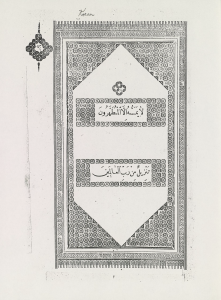
The 1299/1882 Būlāq Qurʾān
This was an early print of the Quran using metal type. informational link.
links to download: high resolution, low resolution.
Excerpt from research on Quran printed editions
The 1299/1882 Būlāq Qurʾān
The Būlāq 1882 edition, was another milestone in paving the way for production of the 1924 Cairo edition and even though it proceeded in time al-Mukhalātī’s edition it however ranks second in importance. What it lacks for in textual importance or influence it makes up for in production value. This edition was typesett using metal type in a naskh style. The type doesnot perfectly match in places where there are gaps a noticeable example is the use of a long kashida in writing the first word “bism” (in the name) where the letter sīn is ellongated but the gaps before and after are noticeable. The Vowelization (ḥarakāt) marks are all on the same height similar to the Kazan Qurʾān and especially for vowels below the line where there are set too low and it can be hard to read and integrate into the word that is being vowelized.
The text is following an Ottoman edition of the Qurʾān as was the practice of the time.[1] There are very few copies of this edition in circuilation and it may be an edition that was printed for 1867 Paris world fair which Būlāq press participated in.[2] Dr. Ahmad Mansour and Dr. Mohamed Hasan were kind enough to provide a picture of the colophon of the copy that is available at Biblioteca Alexandria as the scan of archival copy that is housed at Princeton University library was missing that colophon. It is a 13 line per page and approximately 10 words per line. It does not page numbers, nor any headers, it does have catchwords, it does have the juz numbers in the margins. More importantly it doesn’t have aya numbers but the space is there so it seems either that the printers didn’t agree on a stop marker or that they did not do numbers in the production process. Another comment is that the separate words are at times more often than not, too close together leaving very little space if any at all there by making it harder to read.
Notes:
[1] This is clear from the fact that it doesn’t have hamza on the voweled alif, it doesnot follow the ʿUthmān’s orthography, see al-ʿalāmiyyn 1:2, mālik 1:4, and openning sūra 1:1 is not “bismĀllāh” but the 1:2 starts with “al-ḥamdulliah…”
[2] Given that it lacks some basic essential features (especially page numbers) of other printed Qurʾān had led me to this conclusion. See the appendix for feature comparison of the various printed editions.